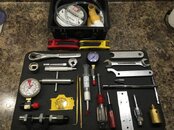Rhyno
Registered
After a few years of diving, and doing standard gear maintenance, I have a desire to start getting a little deeper into my own regs. I'm wanting to be more self sufficient and further my ability to resolve small to moderate problems between dive days. I'm mainly concerned with the Mk17 and Mk25 1st stages and A700, S600, G260 2nd stages in addition to an Air2.
Outside of either the scubatools or scubapro official 'multi-tool' and an IP gauge, what should I look to purchase?
I've ordered the 'regulator savvy' book which I'll soon be going through, and already have all the basic hand tools I'll ever need. What I'm interested in is what scuba specific tools that I would actually benefit from. Looking at the service manuals for the above regulators, it seems as though Scubapro wants me to have an entirely different tool cabinet just to service regs.
I'm considering the field handle (to steady the first stage in a vice), and 'Dual Drive Inline Adjusting Tool'. ScubaPro manuals state the S600 needs a 'Balance Chamber Adjusting Tool' yet others state it's not required.
I've noticed the Air2 has a specialty tool for adjusting cracking pressure and removal of the exhaust valve spider. Both of these functions can be handled with simple hand tools. I'm not opposed to buying the right tools, I want to avoid buying something simply because scubapro says so.
I apologize if this question has been asked numerous times, it didn't come up when I was searching. If there's another resource someone could point me to I'd greatly appreciate it. I'm in the DM program for a local shop and have access to a great deal of knowledge there. Whenever it's convenient they don't mind sponsoring me in the official Scubapro technician course. Until that time I'd like to get a jump start for the upcoming season.
Thanks!
Outside of either the scubatools or scubapro official 'multi-tool' and an IP gauge, what should I look to purchase?
I've ordered the 'regulator savvy' book which I'll soon be going through, and already have all the basic hand tools I'll ever need. What I'm interested in is what scuba specific tools that I would actually benefit from. Looking at the service manuals for the above regulators, it seems as though Scubapro wants me to have an entirely different tool cabinet just to service regs.
I'm considering the field handle (to steady the first stage in a vice), and 'Dual Drive Inline Adjusting Tool'. ScubaPro manuals state the S600 needs a 'Balance Chamber Adjusting Tool' yet others state it's not required.
I've noticed the Air2 has a specialty tool for adjusting cracking pressure and removal of the exhaust valve spider. Both of these functions can be handled with simple hand tools. I'm not opposed to buying the right tools, I want to avoid buying something simply because scubapro says so.
I apologize if this question has been asked numerous times, it didn't come up when I was searching. If there's another resource someone could point me to I'd greatly appreciate it. I'm in the DM program for a local shop and have access to a great deal of knowledge there. Whenever it's convenient they don't mind sponsoring me in the official Scubapro technician course. Until that time I'd like to get a jump start for the upcoming season.
Thanks!
Last edited:




